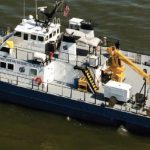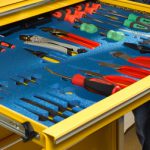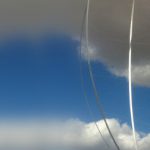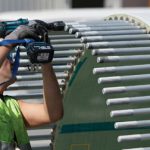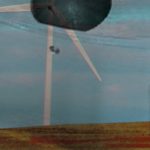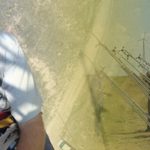Since 2001, M4 Engineering and M4 Wind Services have been offering engineering, manufacturing, monitoring, data analysis, quality control, and maintenance services to the wind industry. Since this qualifies M4 as a broad-based support company, M4 was selected by turbine manufacturers and owner/operators to conduct extensive turbine health studies at various operational sites across the United States. For over two years evaluation points have been measured using accelerometers, strain gauges, thermocouples, and lasers. Reams of data have been collected and analyzed, yielding a starting discovery: the clearest and earliest health indications came from the bending and azimuth measuring devices attached to the main rotor shaft. All other measurements indicated that a problem had already occurred. Measuring the bending moments and torsion loads of the shaft allowed for operational adjustments and general maintenance to be conducted that relieved these stresses on the turbine, preventing equipment problems and extending component life, minimizing unscheduled downtime, and increasing power generation. Hence, Rotor Redline was born.
What is Rotor Redline?
The Rotor Redline system, patent pending, is a completely vertically integrated data acquisition, transmission, reception, conversion, collection, and analysis system that evaluates main shaft loads as a precursor to equipment degradation and an indicator of inefficient wind-to-rotor alignment. State of the art electronics are paired with standard measuring techniques to provide the lowest-cost approach to condition monitoring available in the industry today. Real-time system information is analyzed and translated into executable actions for the end user to perform well in advance of equipment deterioration. Fig. 1 graphically represents the early detection of Rotor Redline, as compared to other industry methods.
Bending and azimuth measuring devices are directly attached to the main shaft to measure moments and torsion loads in a shaft-fixed coordinate system. Rotor azimuth angle is also measured, which allows the load data to be automatically transformed into a nacelle-fixed coordinate system. This information is then transferred wirelessly via the Ethernet cabling installed within the tower. These communications between all of the system’s components utilize the Zigbee Mesh Network protocol that allows for each Rotor Redline to act as its own router, eliminating the need for an on-site network receiver if tower Ethernet is available or allowing for a single network receiver to be installed for any size wind farm, regardless of acreage.
As the load data is received at M4 it is automatically analyzed, taking away the need for data stream interpretation. Abnormal loads are diagnosed for root-cause determination and the corrective action required. These actions are then transmitted to the operator to make control adjustments and schedule/dispatch maintenance personnel. If M4 is responsible for maintenance, personnel are already in route to the site if a critical alert has been generated. In addition, all data is accessible to the customer, and specific comparative data can be downloaded in real time for review and analysis. Fig. 2 provides a simplified overview of the Rotor Redline system.
The Prevailing Winds and Rotor Alignment
Before a turbine is located on a site, tremendous effort is made to determine the best placement and best orientation of the tower to maximize power production. Once erected, anemometers are placed atop the nacelle and offset calculations are made based on their locations relevant to the prevailing winds. This is fed into a software algorithm to give directional control instructions to optimize wind power production at any given time. However, winds are inconsistent and non-uniform, and the calculations are based on averages, hence directional control that is based solely on anemometer readings may have a built in inefficiency of 3-10 percent. Assets believed to be operating at 90-98 percent efficiency are actually operating with rotor-wind misalignment, and revenue is being lost. Rotor Redline fine-tunes your system and allows for recovery of this lost revenue.
For example, the data analysis indicates that the shaft is consistently bending into one direction, and the root cause is identified as yaw misalignment. The action alert sent to the operator would be to adjust the turbine X degrees in the Y/Z direction to reduce the loads and optimize power production. The inefficiency is relieved and maximum revenue generation is obtained, with the side benefit of relieving the bending moments that transmitted negative stresses throughout the turbine system. No induced stresses and strains on components means less degradation and unscheduled downtime for replacing failed parts (see Fig. 3, Fig. 4, Fig. 5).
As noted previously, wind patterns are inconsistent and non-uniform. However, the stresses and strains produced by these winds are shown in consistent patterns. Higher lifts indicate non-uniform aerodynamic imbalances from varying wind speeds. Turbulence is shown as random components of rotor loads. Lower lift tells you that excessive wind shears are present. All creating induced loads that can be offset by operational adjustments. Fig. 6 outlines the Rotor Redline remediation process in relation to directional adjustments and maintenance notifications.
Equipment and Downtime
The prevailing monitoring systems used in wind turbines today are vibration/acoustics controlled for the turbine and optical strain gauged for the blades. In acoustics the noise frequencies of pristine components are loaded into the system, and alerts are given when the sound signature strays out of a certain threshold range. This is an effective and recommended method of determining when a downstream component has already degraded, but it does not give an operator executable actions to perform that may keep that deterioration from occurring. Net result: predictive and reactionary maintenance versus the preventative maintenance of Rotor Redline. (For more information on vibration monitoring equipment see the May/June 2009 edition of this magazine, available online.)
For determining turbine blade health, optical gauges are molded into the blades during manufacture or fitted in the field. A disruption in the optical light path along this gauge indicates that there is an issue and the blade must be inspected for possible repairs. This is effective as long as the damage has occurred along the optical gauge. If damage occurs elsewhere, or if the field-fitted gauge has lost its installation integrity, no damage readings or false damage readings are given. In addition, the optical strain gauge does not give any indication of stresses being introduced to the turbine system, so gearbox—and possibly generator—degradation are occurring. Net result: inconsistent health information versus the consistent feedback of Rotor Redline.
In the previous situational example, rotor-wind misalignment was calculated and fine-tuning of the directional controls was made to improve operational performance. However, Rotor Redline is detecting other anomalies that can be used to also improve operational availability. For example, the data shows a non-uniform load each revolution at the same rotor position regardless of wind direction or strength. The fault determination is a mass imbalance in one of the turbine blades. Inspection and correction is required which will relieve stress on the system and prevent damage to the gears. An action alert is sent to the operator, and a team is dispatched to correct the problem.
An example of a downstream detection could be that there is a constant load peak being applied at the same rotation of the main gear. The fault indication is that there is an excessive buildup of dirt in the lubrication fluid, requiring fluid and filter change plus gear cleaning. This general maintenance notification again relieves the strain on the main drive system and prevents transmission of stresses throughout the turbine. Deterioration due to abnormal loads is prevented, and downtime due to unscheduled maintenance and part failures are avoided.
Determining Remaining Equipment Life
Other than the obvious benefits of being able to fine-tune rotor to wind alignment, schedule maintenance well in advance of component deterioration, or dispatch emergency work crews as soon as critical anomalies are detected, there is a another major benefit to Rotor Redline: real-time life expectancy can be determined for the major components of your turbine.
All manufactured parts have a designed-in fatigue life. Wear and tear during operation and induced stresses and strains are translated into fatigue loads. As more loads are induced, parts wear down and eventually fail (Fig. 7). Given the design characteristics of the component and its fatigue life, M4 engineers can evaluate the condition of these components at the time of Rotor Redline installation. This will establish the baseline condition of the equipment and its operation life remaining. As load data is then acquired, the Rotor Redline system calculates the fatigue loads applied to each component and updates their real-time life remaining.
Operators are now able to know when major components are going to fail and can plan accordingly. Gone are the days of an asset sitting idle as the replacement part is on backorder, or has a long manufacturing lead time. Cash is not tied up in replacement parts that are not yet needed and parts are no longer failing unexpectedly, causing severe damage or failures of other turbine components. As the operator you are now fully in control of your maintenance, replacement, and refurbishment schedules.
Return on Investment
So the Rotor Redline technology sounds good, but what’s the payback? While there are too many variables involved from site to site to make guarantees, we can estimate a maximum ROI of about eight months due to improved power generation, better wind/turbine alignment, and reduced equipment wear and replacement. How? Consider the following.
As presented at a recent AWEA conference, every 1 percent increase in efficiency or asset availability, and every $10K per tower of annual maintenance savings, has a net present value of almost $8,000,000 to the typical 100MW wind farmer. Also, every 1 percent improvement in output and every degree of corrected misalignment result in more than $30K per year per turbine in added revenue. So even the slightest improvement results in a rapid ROI and long-term increased revenue.
Summary
M4’s Rotor Redline system allows an operator to monitor all aspects of their turbine’s performance. Operational adjustments can be made that minimize downtime, extend component life, and maximize power generation. Major maintenance and repairs can be deferred or avoided, advance plans for even long-lead items can be made, and parts can be acquired as a safety net. Additional sensing components can be added, or Rotor Redline can be tied into existing up-tower equipment to provide notification of equipment deterioration. Wind-to-Rotor alignment adjustments can be made to optimize power production and relieve stresses on all of the system components, further reducing downtime and maintenance costs. Rotor Redline truly brings directional control, equipment life, equipment maintenance, and peak performance into one condition monitoring system, providing the wind farmer with operational flexibility and control of their asset’s life.




















